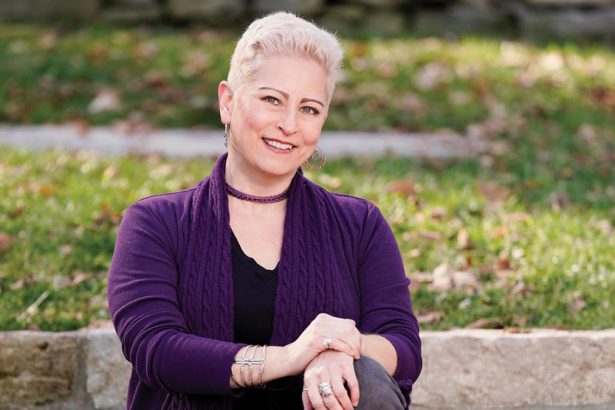Patient Search
 |
 |
|
KaCrole Higgins was diagnosed with breast cancer in 2020. “In May 2020, I found a lump in my breast. I cried. By June, it was diagnosed as breast cancer, triple positive, stage 1A. While getting this cancer diagnosis was devastating, it also became an opportunity. Suddenly, the cancer gave me clarity. It gave me clarity about what was important, what was good in my life, what was toxic in my life, and what I needed to do.” Click below to read more of KaCrole’s story |
If Landon Ryan had been diagnosed with bilateral retinoblastoma 10, 20 or 30 years ago, she might not be here today with nearly perfect vision.Thanks to recent improvements in the treatment for this rare form of cancer that almost exclusively affects children under the age of 5, the diagnosis had the power to change Landon’s life when she was 11 months old, but not to take it — or her eyesight. Click below to learn more about Landon and her story. https://momentum.vicc.org/2022/04/brighter-outlook/ |
Itacitinib for the Treatment Steroid Refractory Immune Related Adverse Events Arising from Immune Checkpoint Inhibitors
Miscellaneous
Miscellaneous
This phase II trial tests how well itacitinib works in in patients with immune related adverse events (irAEs) arising from immune checkpoint inhibitors (ICI) that do not respond to steroids (steroid refractory). Steroids are the usual treatment for these side effects. However, sometimes steroids do not improve or fix the side effects. Giving itacitinib may be effective in treating patients with known or suspected problems coming from ICIs, that do not resolve or improve with steroids, by reducing the patient's immune system response that can cause the irAEs.
Miscellaneous
II
Johnson, Douglas
NCT05660421
VICCCTT2193
Decitabine and Cedazuridine in Combination with Venetoclax for the Treatment of Patients who have Relapsed Acute Myeloid Leukemia after Donor Stem Cell Transplant
Leukemia
Leukemia
This phase II trial tests how well decitabine and cedazuridine (DEC-C) works in combination with venetoclax in treating acute myeloid leukemia (AML) in patients whose AML has come back after a period of improvement (relapse) after a donor stem cell transplant. Cedazuridine is in a class of medications called cytidine deaminase inhibitors. It prevents the breakdown of decitabine, making it more available in the body so that decitabine will have a greater effect. Decitabine is in a class of medications called hypomethylation agents. It works by helping the bone marrow produce normal blood cells and by killing abnormal cells in the bone marrow. Venetoclax is in a class of medications called B-cell lymphoma-2 (BCL-2) inhibitors. It may stop the growth of cancer cells by blocking Bcl-2, a protein needed for cancer cell survival. Giving DEC-C in combination with venetoclax may kill more cancer cells in patients with relapsed AML.
Leukemia
II
Mohan, Sanjay
NCT05799079
VICCHEM2163
Hypofractionated Radiotherapy followed by Surgery for the Treatment of Soft Tissue Sarcomas
Sarcoma
Sarcoma
This phase II trial studies the effect of hypofractionated radiotherapy followed by surgery in treating patients with soft tissue sarcoma. Hypofractionated radiation therapy delivers higher doses of radiation therapy over a shorter period of time and may kill more tumor cells and have fewer side effects. Giving hypofractionated radiotherapy followed by surgery may allow patients with sarcomas to be treated in a much more rapid and convenient fashion.
Sarcoma
II
Shinohara, Eric
NCT04506008
VICCSAR2062
Pembrolizumab after Radiation Therapy and Chemotherapy in Treating Patients with Limited Stage Small Cell Lung Cancer
Lung
Lung
This phase II trial studies how well pembrolizumab after standard treatment with radiation plus the following chemotherapy drugs: cisplatin or carboplatin, plus etoposide works in treating patients with limited stage small cell lung cancer (LS-SCLC). Immunotherapy with monoclonal antibodies, such as pembrolizumab, may help the body's immune system attack the cancer, and may interfere with the ability of tumor cells to grow and spread. Giving pembrolizumab after standard treatment with radiation plus chemotherapy may increase the ability of the immune system to fight LS-SCLC.
Lung
II
Iams, Wade
NCT06140407
VICCTHO22114
Haploidentical Bone Marrow Transplantation in Sickle Cell Patients (BMTCTN1507)
Hematologic
Hematologic
This is a Phase II, single arm, multi-center trial, designed to estimate the efficacy and
toxicity of haploidentical bone marrow transplantation (BMT) in patients with sickle cell
disease (SCD). Based on their age and entry criteria patients are stratified into two groups:
(1) children with severe SCD; and (2) adults with severe SCD.
toxicity of haploidentical bone marrow transplantation (BMT) in patients with sickle cell
disease (SCD). Based on their age and entry criteria patients are stratified into two groups:
(1) children with severe SCD; and (2) adults with severe SCD.
Hematologic
II
Kassim, Adetola
NCT03263559
VICCNCCTT1759
An Imaging Agent (Panitumumab-IRDye800) for the Detection of Head and Neck Cancer During Surgery
Head/Neck
Head/Neck
This phase II trial studies the effect of panitumumab-IRDye800 in detecting head and neck cancer during surgery in patients head and neck cancer. Doctors who perform surgery for head and neck cancer are well-trained in removing all of the cancer that can be seen during the operation; however, there are times when there is cancer that is so small that it cannot be seen by the surgeon. Panitumumab-IRDye800 is a combination of panitumumab and IRDye800CW. Panitumumab works by attaching to the cancer cell in a unique way that allows the drug to get into the cancer tissue. IRDye800CW is an investigational dye that, when tested in the laboratory, helps various characteristics of human tissue show up better when using a special camera. Panitumumab-IRDye800 is a combination of the drug and the dye that attaches to cancer cells and appears to make them visible to the doctor when he or she uses the special camera during the surgery. Giving panitumumab-IRDye800 may help doctors better identify cancer in the operating room.
Head/Neck
II
Rosenthal, Eben
NCT04511078
VICCHN21109
Evorpacept (ALX148) in Combination With Pembrolizumab in Patients With Advanced Head and Neck Squamous Cell Carcinoma (ASPEN-03)
Head/Neck
Head/Neck
A Phase 2 Study of Evorpacept (ALX148) in Combination With Pembrolizumab in Patients With
Advanced Head and Neck Squamous Cell Carcinoma.
Advanced Head and Neck Squamous Cell Carcinoma.
Head/Neck
II
Choe, Jennifer
NCT04675294
VICCHN20127
Niraparib and Dostarlimab as Neoadjuvant Treatment for Patients with BRCA-Mutated or PALB2-Mutated Stage I-III Breast Cancer
Breast
Breast
This phase II trial studies the effects of niraparib in combination with dostarlimab prior to surgery in treating BRCA-mutated or PALB2-mutated stage I-III breast cancer. Niraparib is a PARP inhibitor, which means that it blocks an enzyme (proteins that help chemical reactions in the body occur) in cells called PARP. PARP helps repair deoxyribonucleic acid (DNA) when it becomes damaged. Blocking PARP may help keep cancer cells from repairing their damaged DNA, causing them to die. PARP inhibitors are a type of targeted therapy. Dostarlimab stimulates the immune system by blocking the PD-1 pathway. The PD-1 pathway controls the bodys natural immune response, but for some types of cancer, the immune system does not work as it should and is prevented from attacking tumors. Dostarlimab works by blocking the PD-1 pathway, which may help your immune system identify and catch tumor cells. Giving niraparib in combination with dostarlimab may work better against the tumor and maximize tumor shrinkage before surgery.
Breast
II
Abramson, Vandana
NCT04584255
VICCBRE2190
Conditioning SCID Infants Diagnosed Early
Multiple Cancer Types
The investigators want to study if lower doses of chemotherapy will help babies with SCID to
achieve good immunity with less short and long-term risks of complications after
transplantation. This trial identifies babies with types of immune deficiencies that are most
likely to succeed with this approach and offers them transplant early in life before they get
severe infections or later if their infections are under control. It includes only patients
receiving unrelated or mismatched related donor transplants.
The study will test if patients receiving transplant using either a low dose busulfan or a
medium dose busulfan will have immune recovery of both T and B cells, measured by the ability
to respond to immunizations after transplant. The exact regimen depends on the subtype of
SCID the patient has. Donors used for transplant must be unrelated or half-matched related
(haploidentical) donors, and peripheral blood stem cells must be used. To minimize the chance
of graft-versus-host disease (GVHD), the stem cells will have most, but not all, of the T
cells removed, using a newer, experimental approach of a well-established technology. Once
the stem cell transplant is completed, patients will be followed for 3 years. Approximately
9-18 months after the transplant, vaccinations will be administered, and a blood test
measuring whether your child's body has responded to the vaccine will be collected.
achieve good immunity with less short and long-term risks of complications after
transplantation. This trial identifies babies with types of immune deficiencies that are most
likely to succeed with this approach and offers them transplant early in life before they get
severe infections or later if their infections are under control. It includes only patients
receiving unrelated or mismatched related donor transplants.
The study will test if patients receiving transplant using either a low dose busulfan or a
medium dose busulfan will have immune recovery of both T and B cells, measured by the ability
to respond to immunizations after transplant. The exact regimen depends on the subtype of
SCID the patient has. Donors used for transplant must be unrelated or half-matched related
(haploidentical) donors, and peripheral blood stem cells must be used. To minimize the chance
of graft-versus-host disease (GVHD), the stem cells will have most, but not all, of the T
cells removed, using a newer, experimental approach of a well-established technology. Once
the stem cell transplant is completed, patients will be followed for 3 years. Approximately
9-18 months after the transplant, vaccinations will be administered, and a blood test
measuring whether your child's body has responded to the vaccine will be collected.
Hematologic,
Pediatrics
II
Connelly, James
NCT03619551
VICCNCPED18122
Ramucirumab and Trifluridine/Tipiracil or Paclitaxel for the Treatment of Patients with Previously Treated Advanced Gastric or Gastroesophageal Junction Cancer
Gastric/Gastroesophageal
Gastric/Gastroesophageal
This phase II trial studies the effect of the combination of ramucirumab and trifluridine/tipiracil or paclitaxel in treating patients with previously treated gastric or gastroesophageal junction cancer that has spread to other places in the body (advanced). Ramucirumab may damage tumor cells by targeting new blood vessel formation. Trifluridine/tipiracil is a chemotherapy pill and that may damage tumor cells by damaging their deoxyribonucleic acid (DNA). Paclitaxel may block cell growth by stopping cell division which may kill tumor cells. Giving ramucirumab and trifluridine/tipiracil will not be worse than ramucirumab and paclitaxel in treating gastric or gastroesophageal junction cancer.
Gastric/Gastroesophageal
II
Gibson, Mike
NCT04660760
VICCGI2168



